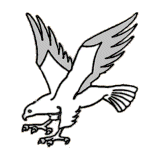Close Menu

The Gyrfalcon is the largest of the true falcons. A bird of the arctic regions, it is circumpolar in distribution, occupying most of the land masses in the northern parts of the Northern Hemisphere. It occurs in three distinct color phases: dark, gray and white. In its latter form, the white Gyrfalcon is perhaps the most spectacular of all raptors, a bird most aspiring falconers can only dream of owning.
When falconry flourished in medieval Europe, ownership of Gyrfalcons was restricted to emperors and kings. Until quite recently, before Gyrfalcons were being bred in captivity and offered for sale by breeders, wealthy Arabs willingly paid upward of $100,000 for a single white Gyrfalcon!
Considerably larger and heavier than its well known cousin, the Peregrine, the Gyrfalcon is more nearly the size of the average Red-tailed Hawk. The males weigh in at about two and a half pounds, the females at three and a half. As with almost all raptors, females are larger and heavier than males.
Nest sites are most often situated on cliff faces offering a commanding view of the territory beyond. As with all falcons, no real nest is constructed. A shallow scrape on a ledge, usually with a protective overhang, holds the average clutch of four eggs, which hatch about a month later. The young remain in the nest for about seven weeks before attempting solo flights. They remain dependent upon their parents for a number of weeks thereafter, until hunting skills are developed.
Gyrfalcons prey mostly on birds, but readily take various small and medium-sized mammals when opportunity dictates. Ptarmigans are most frequently taken when available, but when lemmings peak, these small rodents are taken with relish. Ducks, shorebirds and even geese are taken.
Most Gyrfalcons are non-migratory, but may be forced to wander great distances during winter in search of food, and may be forced south in response to waning daylight. The appearance of a wintering Gyrfalcon anywhere in the lower 48 always generates a great deal of interest among local birding groups, and the news travels instantly across the Internet.
Unlike the Peregrine, which often flies and "waits on" at considerable heights when hunting, then dives, or "stoops," at dizzying speeds in pursuit of prey, the Gyrfalcon tends to fly closer to the ground and tail chases its quarry in much the same fashion as the Prairie Falcon.
Although slower than the other falcons as it begins its chase, the Gyrfalcon rapidly gains momentum and is able to out fly the fastest duck. Its persistence in the chase is the one trait that separates it from all others. It never gives up. It will literally pursue its quarry until capture, or until the quarry is lucky enough to find refuge. Falconers have long admired this aspect of the Ggyrfalcon's nature. But its determination, often in a chase of over a mile, can easily lead to a lost bird ... and a very heartsick falconer.
Length: 22 inches.
Ron Austing

This is Falcon Country
Lt. Colonel William H. Wise chose the Gyrfalcon as the insigna for the 1041st SPS (T)
and the 82nd CSP Wing "after several people" suggested a variety of symbols.
Lt. Colonel William (Wild Bill) Wise was Commander of the 1041st SPS (T)
and Deputy Commander of the 82nd CSP Wing.
John W Brokaw, PhD
Historian, Air Force Security Police Association
821st base camp bunker photo courtesy: Colonel Lowell P. Little 822nd